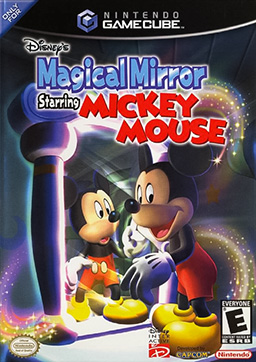Disney's Magical Mirror Starring Mickey Mouse
Disney's Magical Mirror Starring Mickey Mouse, known in Japan as Mickey Mouse no Fushigi na Kagami (ミッキーマウスの不思議な鏡, lit. Mickey Mouse's Mysterious Mirror), is a 2002 Disney adventure video game developed by Capcom, published by Nintendo and Disney Interactive for the Nintendo GameCube.
| Disney's Magical Mirror Starring Mickey Mouse | |
|---|---|
 North American cover art | |
| Developer(s) | Capcom |
| Publisher(s) | Nintendo |
| Director(s) | Makoto Ikehara Kosuke Nasu Toshihiko Kurata Takanori Uegaki |
| Producer(s) | Shigeru Miyamoto Luigi Priore Kenji Miki Tatsuya Minami Hironobu Tekeshita |
| Composer(s) | Seiko Kobuchi |
| Platform(s) | Nintendo GameCube |
| Release | |
| Genre(s) | Adventure |
| Mode(s) | Single-player |
Gameplay
The game uses a simple point-and-click mechanic which involves using a cursor to guide Mickey Mouse to various locations. Mickey will react to what the player does and what he encounters in the game by expressing curiosity, getting mad, falling down, running away, standing his ground, or other actions. At certain points, the player is able to have Mickey perform a special move that generally involves having him stomp on an onscreen enemy.
Mini-games, such as having Mickey fly an airplane or ski down a mountain, are available throughout the game. Special souvenirs may be uncovered as well, which are displayed in Mickey's room at the end of the game, such as Pluto's collar or Minnie's bow.
Plot
One night when Mickey is fast asleep, he falls into a dream where a mischievous ghost traps a dream vision of himself inside a magic mirror. Stuck in an alternate universe that strangely resembles his own house, Mickey yearns to get back through the mirror to his own house and his own bed in order to wake up from this dreamlike state; however, the ghost destroys the mirror and the pieces shrink and fly off to different areas around the house, which turns the magic mirror into a normal mirror. The player must direct Mickey to outwit and pull gags in order to get past enemies, obstacles, and the aforementioned ghost and recover the twelve broken mirror pieces he needs to go home again and search for twelve magic stars (needed to pull gags) and items needed to help him throughout his quest. Whenever he finds a piece, it will fly back to the mirror, return to its normal size, and put itself back in place. After repairing the mirror, he prepares to leave, but the ghost stops him, revealing that it only brought him here so he can have someone to play with. The player could either chose to stay or go. Choosing to stay will make the ghost run off, leaving Mickey stuck in the alternate world until he reenters the mirror room where the player can choose to stay or leave again. If the player chooses to leave, Mickey says goodbye to the ghost and begins to go home, but the ghost decides to go with him (only if the player has collected all twelve mirror pieces). After Mickey wakes up, he goes downstairs to get something to eat. A model of the ghost is shown hanging on the ceiling fan and the ghost's laughter is heard.
Development
At Nintendo's Space World 2001 show, where it was just beginning to show more Nintendo Gamecube titles, a Disney title was announced which showed some screenshots of this game, which was assumed to be a platformer like much the vein of Disney's Magical Quest on the Super NES. But when Nintendo finally announced the product at the 2002 Electronic Entertainment Expo, this was proved that it was a completely different game instead.
This game's plot was based on "Thru the Mirror", a 1936 Mickey Mouse cartoon. The opening sequence also plays out similar to the beginning of the cartoon, even perfectly replicating Mickey's "walk through the mirror" animation. One part later in the game, where Mickey grows to a tremendous size then shrinks to a minuscule size, was also replicated exactly as in the cartoon.
Reception
| Reception | ||||||||||||||||||||||
|---|---|---|---|---|---|---|---|---|---|---|---|---|---|---|---|---|---|---|---|---|---|---|
| ||||||||||||||||||||||
The game received mixed to negative reviews. For the most part, the player is given no instructions and cut scenes are limited to watching Mickey get chased or falling through to the next area.[7][8][9][10]
References
- "Disney's Magical Mirror: Starring Mickey Mouse". Nintendo Australia. Archived from the original on 2002-12-06. Retrieved 2010-03-02.
- "Aggregate score at GameRankings". GameRankings. Retrieved 2008-08-30.
- "Aggregate score at Metacritic". Metacritic. Archived from the original on 2008-09-13. Retrieved 2008-08-30.
- Ryan Davis (August 21, 2002). "Review at GameSpot". GameSpot. Archived from the original on May 16, 2008. Retrieved 2008-08-30.
- Shane Satterfield (September 5, 2002). "Review at GameSpy". GameSpy. Archived from the original on October 5, 2008. Retrieved 2008-08-30.
- Fran Mirabella III (September 11, 2002). "Review at IGN". IGN. Retrieved 2008-08-30.
- Ryan Davis (August 21, 2002). "Review at GameSpot". GameSpot. Archived from the original on May 16, 2008. Retrieved 2008-08-30.
- Shane Satterfield (September 5, 2002). "Review at GameSpy". GameSpy. Archived from the original on October 5, 2008. Retrieved 2008-08-30.
- Fran Mirabella III (September 11, 2002). "Review at IGN". IGN. Retrieved 2008-08-30.
- "Aggregate score at Metacritic". Metacritic. Archived from the original on 2008-09-13. Retrieved 2008-08-30.